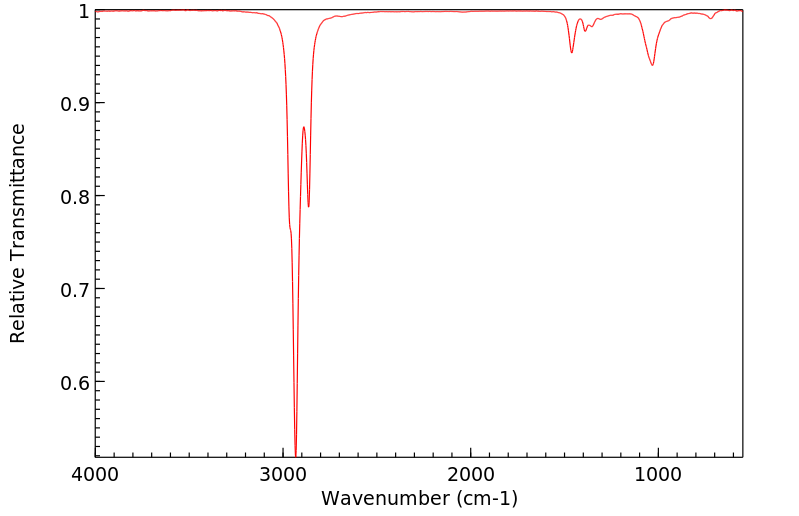十四烷基氟 | 593-33-9
中文名称
十四烷基氟
中文别名
1-氟十四烷;1-氟四癸烷;氟十四烷
英文名称
1‐fluorotetradecane
英文别名
1-fluorotetradecane;Tetradecyl fluoride;1-fluoro-tetradecane;1-Fluor-tetradecan;Tetradecylfluorid
CAS
593-33-9;73180-09-3
化学式
C14H29F
mdl
MFCD00042114
分子量
216.383
InChiKey
YRDSYPITPPQNED-UHFFFAOYSA-N
BEILSTEIN
——
EINECS
——
-
物化性质
-
计算性质
-
ADMET
-
安全信息
-
SDS
-
制备方法与用途
-
上下游信息
-
文献信息
-
表征谱图
-
同类化合物
-
相关功能分类
-
相关结构分类
物化性质
-
沸点:285.53°C (estimate)
-
密度:0.812 g/mL at 25 °C(lit.)
-
闪点:>230 °F
计算性质
-
辛醇/水分配系数(LogP):7.2
-
重原子数:15
-
可旋转键数:12
-
环数:0.0
-
sp3杂化的碳原子比例:1.0
-
拓扑面积:0
-
氢给体数:0
-
氢受体数:1
安全信息
-
海关编码:2903399090
SDS
反应信息
-
作为反应物:描述:十四烷基氟 在 2,2,6,6-四甲基哌啶 、 三(五氟苯基)硼烷 、 氘 作用下, 以 二氯甲烷 为溶剂, 20.0 ℃ 、120.0 kPa 条件下, 反应 16.0h, 以93%的产率得到1‐[2H]‐tetradecane参考文献:名称:烷基 CF 基团的三硫脱氟摘要:报道了一种用氚/氘取代氟的简单方法。所述方法对 FC (sp3 ) 基团具有选择性,并且不影响芳族 FC (sp2 ) 和 F2 -C (sp3 ) 部分。烷基氟化物,通过用二乙氨基三氟化硫 (DAST) 试剂处理,很容易从合适的醇合成,总产率高达 76%,用硼基路易斯酸 B(C6 F5 )3 进行活化,并用三碘化物/氘化物试剂 - 受挫路易斯对的 [TMP2(3) H][2(3) HB(C6 F5 )3 ] 系统。这种方法提供了高达 93% 的区域特异性标记的小有机化合物的分离产率,其 2 H 富集率超过 95%。制备的 1-(2-[3 H]-乙基)萘的比活性测定为 29.0 Ci/mmol。路易斯酸/[TMP2(3) H][2(3) HB(C6 F5 )3 ] 方法的位点选择性与当前使用的方法正交,并允许对分子中的互补位置进行同位素标记。报告的标记方法在超温和反应条件(220 毫巴 TDOI:10.1002/jlcr.3782
-
作为产物:参考文献:名称:烷基碘的氟化Deiodinative与p -iodotoluene二氟摘要:用对碘代甲苯二氟化物(4)对烷基碘进行氧化氟化。在Et 3 N–4HF的存在下,伯烷基碘化物的氟化反应在温和条件下在碘位置上选择性发生,从而以高收率得到相应的烷基氟化物。DOI:10.1016/s0040-4020(01)00201-0
文献信息
-
Lewis Acid Triggered Reactivity of a Lewis Base Stabilized Scandium-Terminal Imido Complex: C–H Bond Activation, Cycloaddition, and Dehydrofluorination作者:Jiaxiang Chu、Xianghao Han、Christos E. Kefalidis、Jiliang Zhou、Laurent Maron、Xuebing Leng、Yaofeng ChenDOI:10.1021/ja5061559日期:2014.8.6A stable scandium-terminal imido complex is activated by borane to form an unsaturated terminal imido complex by removing the coordinated Lewis base, 4-(dimethylamino)pyridine, from the metal center. The ensuing terminal imido intermediate can exist as a THF adduct and/or undergo cycloaddition reaction with an internal alkyne, C-H activation of a terminal alkene, and dehydrofluorination of fluoro-substituted
-
Fluorination of Secondary and Primary Alcohols by Thermal Decomposition of Electrochemically Generated Alkoxy Triphenylphosphonium Tetrafluoroborates.作者:Hatsuo MAEDA、Takashi KOIDE、Sayaka MATSUMOTO、Hidenobu OHMORIDOI:10.1248/cpb.44.1480日期:——Replacement of hydroxyl groups in secondary and primary alcohols (1) with a fluorine atom arising from tetrafluorobote anion has been performed by the electrochemical formation of alkoxy triphenylphosphonium tetrafluoroborarates (2) from 1, followed by their thermal decomposition. The procedure is quite simple, involving : (1) constant-current electrolysis of a mixture of 1, Ph3P, and Ph3PH·BF4 in CH2Cl2 in an undivided cell; (2) refluxing a tetrahydrofuran or dioxane solution of the residue afforded by evaporation of the solvent in vacuo after the electrolysis. Cyclic secondary alcohols such as 3β-hydroxy steroids and 2-adamantanol are transformed into the corresponding fluorides in satisfactory yields when the geometry of the leaving group in 2 is suitable for the substitution or an elimination process for 2 to give an alkene is stereochemically forbidden. The fluorination of steroidal alcohols and 4-phenyl-1-cyclohexanol proceeded with complete inversion, demonstrating that a fluorine atom from the tetrafluoroborate anion attacks from the side opposite to the phosphonium moiety in 2 via an SN2 mechanism rather than as SN1 mechanism. The fluorination of acyclic secondary and primary alcohols was performed by the present method in reasonable yields, although the reaction for the latter required more forcing conditions, such as refluxing in dioxane.次级和初级醇(1)中的羟基被四氟硼酸根衍生的氟原子取代,通过电化学形成烷氧基三苯基膦四氟硼酸盐(2),然后进行热分解来实现。该过程相当简单,包括:(1)在无隔膜电池中对1、Ph3P和Ph3PH·BF4的CH2Cl2混合物进行恒电流电解;(2)将电解后在真空下蒸发溶剂得到的残渣的四氢呋喃或二氧六环溶液回流。当2中的离去基团的构型适合取代或消除过程,且2生成烯烃的立体化学被禁止时,环状次级醇如3β-羟基甾体和2-金刚烷醇可转化为相应的氟化物,产率令人满意。甾醇和4-苯基-1-环己醇的氟化反应进行完全反转,表明四氟硼酸根阴离子中的氟原子通过SN2机制从2中膦部分的对面攻击,而不是SN1机制。通过本方法,无环次级和初级醇的氟化反应在合理产率下进行,尽管后者的反应需要更强烈条件,如在二氧六环中回流。
-
Synthesis of Highly Reactive Sulfone Iminium Fluorides and Their Use in Deoxyfluorination and Sulfur Fluoride Exchange Chemistry作者:James A. Vogel、Rania Hammami、Ara Ko、Hiya Datta、Yael N. Eiben、Karley J. Labenne、Ellis C. McCarver、Ebrar Z. Yilmaz、Patrick R. MelvinDOI:10.1021/acs.orglett.2c02232日期:2022.8.19We report the synthesis of sulfone iminium fluorides (SIFs), a reactive class of sulfur(VI) molecules. The synthesis is tolerant of a variety of substituents on the sulfur and nitrogen components. The SIF reagents were applied to the deoxyfluorination of alcohols and carboxylic acids, providing high yields of fluorinated products in 60 s at room temperature. The SIF reagents were then utilized in sulfur
-
COMPOSITION, FILM, MULTILAYER STRUCTURE, LIGHT EMITTING DEVICE AND DISPLAY申请人:Sumitomo Chemical Company Limited公开号:EP3643764A1公开(公告)日:2020-04-29A light-emitting composition including: semiconductor fine particles as component (1); and a compound represented by Formula (X) or a modified product thereof as component (2).一种发光组合物,包括:作为组分(1)的半导体微粒;以及作为组分(2)的由式(X)代表的化合物或其改性产物。
-
Microfluidic apparatus having an optimized electrowetting surface and related systems and methods申请人:Berkeley Lights, Inc.公开号:US10799865B2公开(公告)日:2020-10-13Microfluidic devices having an electrowetting configuration and an optimized droplet actuation surface are provided. The devices include a conductive substrate having a dielectric layer, a hydrophobic layer covalently bonded to the dielectric layer, and a first electrode electrically coupled to the dielectric layer and configured to be connected to a voltage source. The microfluidic devices also include a second electrode, optionally included in a cover, configured to be connected to the voltage source. The hydrophobic layer features self-associating molecules covalently bonded to a surface of the dielectric layer in a manner that produces a densely-packed monolayer that resists intercalation and or penetration by polar molecules or species. Also provided are microfluidic devices having an electrowetting configuration that further include a section or module having a dielectrophoresis configuration; systems that include any of the microfluidic devices in combination with an aqueous droplet and a fluidic medium immiscible with the medium of the aqueous droplet; related kits; and methods of manipulating droplets, optionally containing micro-objects such as biological cells, within the microfluidic devices.
表征谱图
-
氢谱1HNMR
-
质谱MS
-
碳谱13CNMR
-
红外IR
-
拉曼Raman
-
峰位数据
-
峰位匹配
-
表征信息
同类化合物
顺式-2-氟-环丙胺
顺式-1,1,1,4,4,4-六氟-2-丁烯
顺-1,1,2,2,3,4-六氟环丁烷
酰亚胺基二亚磷酸,甲基-,四(2,2,2-三氟乙基)酯
舒巴坦酸
聚(7-脱氮杂腺嘌呤酸)
癸烷,6-溴-1,1,1,2,2,3,3-七氟-4,4-二(三氟甲基)-
环丙基溴化镁
溴五氟乙烷
氯氟烃-252
氯氟烃-232
氯氟-甲基
氯四氟乙烷
氯二氟乙醛
氯三氟乙烷
氨甲酸,(氟磺酰)-,甲基酯
氢氯氟碳-261
氟甲醇
氟甲基自由基
氟甲基环戊烷
氟甲基环丙烷
氟环辛烷
氟环戊烷
氟环庚烷
氟环十二烷
氟环丁烷
1-溴-1-氯-2,2,2-三氟乙烷
氟氯乙烷
氟化烯丙基
氟化乙亚胺酰基,2-(二氟氨基)-N,2,2-三氟-
氟化丁基
氟乙醛
氟乙烷
氟乙烯醚
正膦胺,N-(2,3,4,5,6-五氯-2,3,4,5,6-五氟亚环己基)-1,1,1,1-四(2,2,3,3-四氟丙氧基)-
桉叶素
替氟烷
恩氟烷
异氟醚
异十八烷酸己酯
己酸,2,5-二氨基-6-羟基-(7CI)
奥替尼啶HCL
壬氟环戊烷
地氟烷
叔丁基氟化物
反式-2-氟环丙胺盐酸盐
反式-2-氟代环戊烷-1-胺盐酸盐
反式-1,2-双(全氟己基)乙烯
反式-1,2-双(全氟-n-丁基)乙烯
反式-1,1,1,2,2,3,3-七氟-4-壬烯







